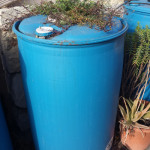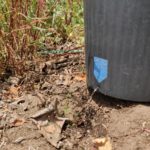What is good mulch?
Nature abhors bare soil. — Emila Hazelip, French Permaculturist
Next time you take a walk in a nature space, say, the Santa Monica Mountains, notice the soil surface. Left to her own doings, Mother Nature covers her soil. Shrubs and trees drop leaves, small plants grow shoulder-to-shoulder, all to shield the soil surface from the sun.
Like all living organisms, soil critters need Food, Water, Shelter & Protection, and a Place to raise young. Mulch offers many benefits …
Water: Mulch can slow water evaporation, which means the precious water you give to your garden lingers longer to benefit your soil organisms and plants.
Food: Over time, organic mulch (things that used to be plants) breaks down, which makes mulch a long-term feed stock for our living soil organisms.
Shelter and protection: Mulch protects soil organisms from the UV and heat of the sun. It can also help shield delicate soil critters from birds and other predators.
Place to raise young: At the very surface of the soil, along that interface between the top of the soil and the bottom of the mulch, there is a rich bio-active zone.
Some mulches achieve all these fantastic purposes better than others. Remember to evaluate any possible mulch from the point of view of your earthworms, your soil critters: Is this particular mulch going to make things better or worse for them?
Excellent sources of mulch
- fallen leaves
- wood chips dumped by tree pruning service.
- straw (bedding) sold by animal supply store.
- pine needles – in Southern California we don’t need to worry about the acidity, in fact we need it
- chop-and-drop practices with garden trimmings
Mulches with mixed review
- “free mulch” from the city – okay for pathways in ornamental gardens, but not recommended for food gardens. Because it’s collected from all the green bins in the local neighborhood, you don’t know what’s in it — people have reported finding glass, metal, dog poop.
- redwood mulch (bagged at garden center). In my observation it seems to discourage seedlings from sprouting. (it’s allelopathic) However the fact that it doesn’t decompose, or it seems to take years to decompose, tells us that it isn’t offering an ongoing food source to the soil organisms.
- grass clippings – if you cut grass before the seedheads form, it might serve as a good mulch. As the cut grass dries out, make sure it doesn’t mat up and form a barrier so that water can’t get to the soil (fluff the drying grass with a garden tool). Caution: if your grass is forming seedheads when you cut it, send it to the green bin to avoid compounding a weed problem.
- shredded newspaper. If you use the black and white (not the glossy colored stuff), it will break down in the soil just fine. be careful about matting, as described under “grass clippings.” however newspaper doesn’t offer the most gorgeous aesthetic, and in a windy spot it can blow around and create litter.
- cardboard boxes. use only the brown ones, after removing all plastic tape, labels, and staples. cardboard provides a decent short-term weed barrier for broadleaf weeds like dandelions. Caution: cardboard sheet mulching is completely ineffective against Bermuda grass, and may in fact cause Bermuda to thrive.
Poor sources of mulch
- colored mulch (bagged, from the Big Box Stores). Who knows what chemical treatments lurk within.
- hay (animal feed) sold by animal supply store – will likely decompose quickly and have too many seeds. Note that hay and straw are different things.
- wood chips that are all-eucalyptus – 100% eucalyptus may have too many allelopathic oils and prevent plants from growing. However don’t get too compulsive about it. In 11 yrs of experience at the Community Garden at Holy Nativity, we observed that a bit of eucalyptus in a mix of other mulch chips isn’t harmful.
- non-organic materials, such as plastic, tire rubber, gravel, rocks, “landscape fabric”, etc. – some heat up (detrimental to soil life, plus they add to the Heat Island effect which is a problem in cities). some non-organic mulches form a water barrier (detrimental to soil life). inorganic materials don’t decompose, thus they do not offer a long-term food supply for soil life.
- “landscaping fabric” — intended as a weed barrier, it’s basically plastic. it will break down in UV from our intense SoCal sun, creating shreds which blow around, look ugly, and liter the neighborhood with shreds of plastic. it creates a non-organic barrier between the soil surface and whatever mulch got dumped on top of it, so it doesn’t make it easy for soil life to reestablish living soil ecosystems. landscaping fabric also may inhibit water infiltration (when we’re lucky to get rain). Landscaping fabric is completely ineffective against Bermuda grass.




